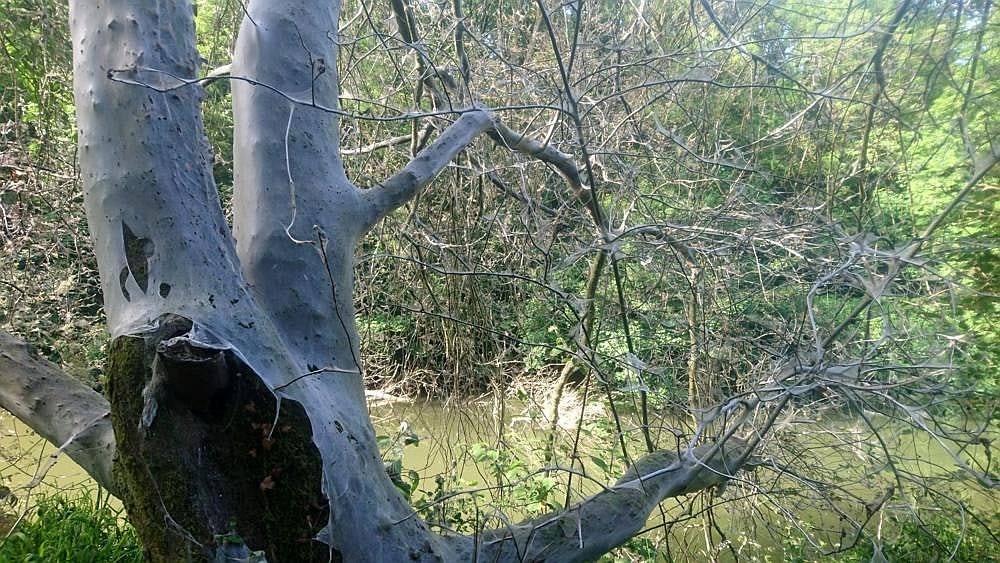Moth tree
Walking along the Avon, from a distance, the trees ahead were possessed with a shimmering sheen, not quite crabapple blossom, not quite the silver of a birch. Something wilder, more of the night.
Happy Friday
And welcome to edition 273. For those of you who are new around these parts, my name is David Charles and I’m a UK-based writer and outdoor instructor.
Today, after an absence of four months, I finally made it back to Brownsea Island to help with the bracken bruising. Bracken is a bit of a pest on the island: completely taking over the understorey and blocking light from reaching the gentler heathland species.
Armed with metal-tipped sticks, we spent the day wading through the chest-high bracken, swishing our weapons of destruction with abandon: backhand, forehand, overhead smash.
The idea of ‘bruising’ is to damage the bracken without breaking the stems: to inflict a wound, but not a mortal one.
Bracken grows from rhizomes—subterranean plant stems that send out roots and shoots from beneath the earth. Once it’s taken hold, bracken is bloody hard to control and can easily take over a forest, throttling other species with its persistence and resistance.
Rather than killing the shoots outright, bruising encourages the rhizome mothership to funnel its energetic resources into repairing injured shoots, rather than colonising the rest of the planet with new roots and shoots.
Bracken is incredibly resistant: it will grow back after bruising. We found shoots that had been whacked a month ago, smashed to the ground—but the growing tip had somehow found the energy to curve back from death’s door, up towards the sunlight, putting on a foot or more of new growth. Bracken will always grow back, but, with its resources drained, only more feebly.
We use bracken’s greatest strength against itself and, in so doing, hope to bring new light to the forest floor, where heather and other marginal species can flourish. Or, as one of the volunteers said: ‘Killing nature in the name of conservation.’
The best solution, as to so many of life’s gnarlier problems, is pigs. Pigs love eating bracken and, during the winter, when nature’s larder grows bare, they will even rootle around in the soil and dig up the rhizomes. Dorset Wildlife Trust hope to have swine in residence on Brownsea in Spring 2022. I can’t wait!
Moth tree
The creepiest experience of the week goes to the dread moth tree:
Walking along the Avon, from a distance, the trees ahead were possessed with a shimmering sheen, not quite crabapple blossom, not quite the silver of a birch. Something wilder, more of the night.
Moving closer, the brain doesn’t trust the eyes and it becomes horrifyingly clear that something really isn’t right. A cluster of trees are not themselves: these mighty, long-lived beasts of carbon and chlorophyll have been usurped by thousands upon thousands of tiny caterpillars.
Ermine moths live in communities of thousands and, every spring, club together to weave layers upon layers of silken webbing over every inch of their host tree. It’s protection for their babies from birds and other predators.
Beneath their safety net, the growing caterpillars have free range over the tree’s larder of leaves. It’s shocking to see spring’s bounty stripped before summer, but at least someone’s eating well.
With every leaf throttled, every twig shrouded in silk and the bark crawling with life, it’s a challenge to identify the victim: I think a bird cherry. Partly because the leaves of neighbours look similar, partly because of the riverside location, and partly because one species of small ermine moth LOVES to call the bird cherry home.
Despite their horrifing aspect, these poor cherries should make a complete recovery over the summer. Ermine moths rarely pick on the same tree twice.
Thanks to H.S. for hosting and introducing me to the wondrous moth tree!
This email was 12.34 percent funded
▲▲▲▲△△△△△△△△△△△△△△△△△△△△△△△△△△△△△
These words are entirely supported by lovely readers who reckon this newsletter is worth some of their hard earned dosh. If today’s story has made your inbox a better place, then I’d be honoured if you clicked one of these soothing lavender-coloured buttons:
Thank you.
100 Days of Adventure
🟢🟢🟢🟢🟢🟢🟢🟢🟢🟢🟢🟢🟢🟢🟢🟢🟢🟢🟢🟢🟢🟢🟢🟢⚪
⚪⚪⚪⚪⚪⚪⚪⚪⚪⚪⚪⚪⚪⚪⚪⚪⚪⚪⚪⚪⚪⚪⚪⚪⚪
⚪⚪⚪⚪⚪⚪⚪⚪⚪⚪⚪⚪⚪⚪⚪⚪⚪⚪⚪⚪⚪⚪⚪⚪⚪
⚪⚪⚪⚪⚪⚪⚪⚪⚪⚪⚪⚪⚪⚪⚪⚪⚪⚪⚪⚪⚪⚪⚪⚪⚪
That’s it for this week. I’m going to lie down and attempt to digest the first proper fuul sandwich that I’ve eaten since I was last in Egypt, eleven years ago. Big shout out to Pondok (and thanks to E.F. for the introduction!)
What a discovery: an Egyptian fast food cafe right on my doorstep. The woman who served us explained that Pondok means ‘odd-job man’—chosen because the cafe does a little bit of everything. Oh, and yes, the falafel are made properly, with broad beans.
Have a great weekend.
Big love,
dc:


